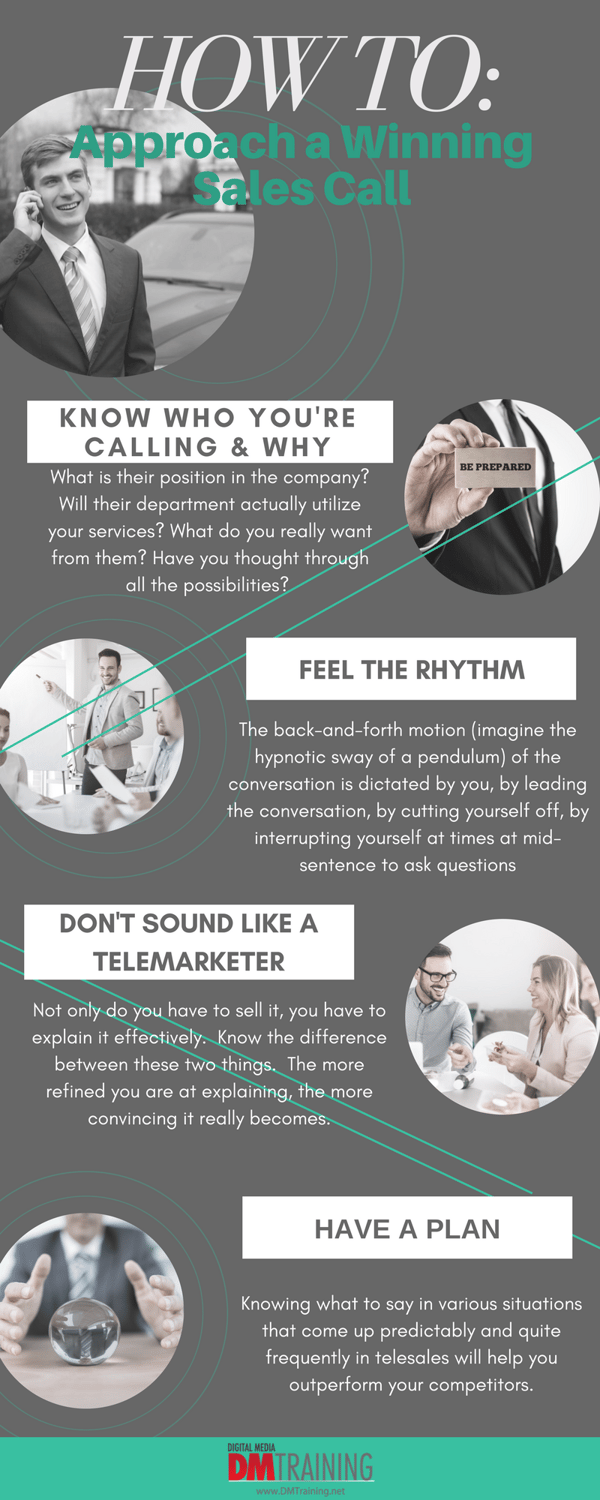How To Approach a Winning Sales Call
In an ideal world, every sales call would be a winning sales call. Unfortunately, this is not the world we live in; however, with the following tips you can increase your number of sales wins without having to drastically change your approach.
The key differences between a successful seller and a mediocre one are nuanced in nature. It comes down to who is more prepared, who has gone out of their way to get to know the client, and who is able to sell simply through rhythm of conversation rather than an overly rehearsed and stiff pitch.
We've broken down our recommended winning sales approach into four categories (we've even created an infographic you can use as a handy reference). Read through and see if you can incorporate the following strategy into your next sales call!
Know Who You're Calling (and Why)
Knowing who you're calling is about more than just reading a name off your calling list. With the extensive (and free) digital tools available at your fingertips, it is easier than ever to get to know your prospects.
Today we actually have the opportunity to informally get to know someone before ever officially meeting them (Something salespeople of the past likely would have killed for). A quick perusal through social media can tell you everything from a prospects' hobbies to their business pain points. In this case, LinkedIn is your best friend for social selling- use it! Consider the fact that the top sales cold callers use LinkedIn on average about 6 hours per week.
To help you understand who you're calling and why, review the following questions before launching into your next sales call:
- Are we calling somebody who runs a division and who is likely to have the authority to make a decision regarding the budget? Are we talking to somebody who runs or owns the company?
- Are we talking to someone whose department and division would actually utilize our services and reap the benefits?
- What do we really want from this person?
Are we looking for his or her permission to call somebody who is higher up in the company? Are we calling because we want an appointment? If so, why do you think that he's the right person to begin with?
- Have you thought through all the possibilities?
Let's say we get "kicked downstairs," which sometimes happens when we call someone and we're told to speak to some assistant or someone else with less authority. Do you want to start low? Honestly, the best move would be to start as high as possible - at the highest possible position that would make sense. Therefore, we must understand the benefits we can offer. What are the words that they're going to need to hear, given their responsibilities and our offering?
Go With the Flow
The most important part of winning a sales call is to go with the rhythm of the conversation. What do you normally do when you’re on the phone with people? Often times, when I listen to sales people on the phone speaking with their customers, I get a sense that the salesperson is too determined to run through their presentation and all their well-rehearsed thoughts. This means that they are sounding overly formal and they’re not giving the customer a chance to talk. This does not bode well for winning a sale. It could also be why up to 85% of prospects are dissatisfied with their sales call experiences. It's time to change the narrative!
For both the seller and the customer, the sense of time passing is very different. Sellers already know what they are going to say, because they've (hopefully) been practicing. In fact, most sales conversations will go through a recycling process, with identical exoskeletons and small components changed to fit a prospect's situation and business needs. Sellers are really good at their end of that conversation because they know what to ask, what to follow up with next, and how to proceed further. They've had similar conversations to this a million times before; however, the customer has not.
The customer is likely not as practiced at answering the questions. What has generally been found to be true is that the higher level the person is, the more skillful he is in selecting his words. Sometimes, this can lead to an even longer pause when you ask a question – the pause between the end of your question and the beginning of the answer. You want to allow that pause to continue. Do not race to fill that up. In fact, a lack of those pauses is a good indicator that your rhythm with a prospect might be off. Conversational pauses are healthy and the only places they do not exist are in movies and rushed sales conversations.
If you’re cutting into each other’s sentences and not listening, you’re not getting the silences you need to construct that rhythm. If you’re doing all the talking, you’re not encouraging any rhythm at all.
The back-and-forth motion (imagine the hypnotic sway of a pendulum) of the conversation is dictated by you, by leading the conversation, by cutting yourself off, by interrupting yourself at times in mid-sentence to ask questions like:
- Let me just ask you...
- As I just mentioned, this word, this concept, this offering (explain further)...
- What do you think about...?
- Did you ever think about...?
- I was just wondering if you've considered....
Insert your questions whenever possible to pull them back into the conversation!

Don't Sound Like a Telemarketer
When you’re explaining what you do, that’s great! But when somebody asks you to explain what you do and you can't un-bundle this point from your sales pitch, you’re not being helpful. Not only do you have to sell it, you have to explain it effectively. Think of great teachers you've had in the past. They managed to engage you with new information via compelling stories without making you feel like you were sitting through a dull presentation. You should aim to convey your informative pitch in a similar manner. Know the difference between these two things. The more refined you are at explaining, the more convincing it really becomes.
There are some people that just can’t get out a clear explanation without turning it into a full blown infomercial that makes what they’re selling incomprehensible. That’s what telemarketers do. They neither fully understand the questions nor follow the conversation. They’ll say to a customer, “Well, let me get back to that. But right now, what I want to tell you is” – let the customer lead and ask the questions that they need to ask. By doing this you'll end up learning more about what they need, which will help you know what angle to direct the sale.
Go In With a Plan
In fact, go in with multiple plans! Have Plans B, C, and D ready and dressed to accompany Plan A. 42% of salespeople feel like they don't have enough information before making a call, luckily this is an easy problem to solve.
If you go and can’t reach the person, then what next? If you are able to reach the person but he can’t meet with you, what’s the alternative plan? What’s the plan if you get him on the phone, ask for an appointment and you give it your best shot, but he makes an objection?
What’s the plan when you find out that he or she is not the right person to reach out to and he doesn’t assume the type of authority you had expected? Therefore, what do you do? Knowing what to say for all of these various situations that come up predictably and quite frequently in sales will help you outperform your competitors.
So let's review:
1. Know who you’re calling and why.
2. Feel the rhythm of the call.
3. Avoid sounding like a telemarketer.
4. Go in with a plan.
When you have all four of these ready in your front pocket, then you’re ready to make those winning calls. If you incorporate this strategy into your selling technique you will be better prepared, more warmly received by prospects, and even more likely to land an appointment!
About Steve Bookbinder
Steve Bookbinder is the CEO and sales expert at DMTraining. He has delivered more than 5,000 workshops and speeches to clients all over the world and has trained, coached, and managed more than 50,000 salespeople and managers. Steve continuously refreshes his training content to reflect his latest first-hand observations of salespeople across industries and regions. Through him, participants in his workshops and coaching sessions learn the best practices of today’s most successful sellers and managers across industries. Steve understands that sales is a competitive game. To outperform competitors and our own personal best results, we need to out-prospect, out-qualify, out-present and out-negotiate everyone else, not merely know how to sell. Through his specialty programs in Pipeline Management, Personal Marketing, Great First Meetings, 2nd-level Questioning, Sales Negotiating, and Sales Coaching, Steve trains sales teams to master the skills they need to overcome the challenges they face in today’s world… and keep improving results year over year.





